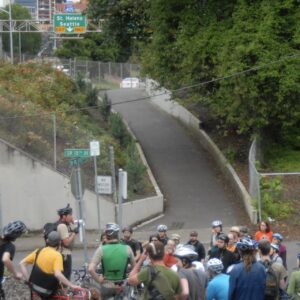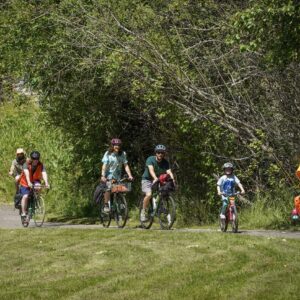
Executive Director Stephanie Routh
speaking at a 2009 event.
(Photo © J. Maus)
On the heels of recent media attention on the need for safer streets and news of an 80% increase in walking-involved fatalities and injury crashes in Oregon this year, the non-profit Willamette Pedestrian Coalition (WPC) unveiled their Getting Around on Foot Action Plan at a press conference in Beaverton today.
The plan presents an overview of challenges our transportation planners face in creating a more walkable (and rollable, in the case of wheelchair and other mobility device users) region. From the Executive Summary (which you can read in its entirety below):

(Photo: WPC)
“The Action Plan is designed to encourage decision-makers who draft policies and direct investments to design a comprehensive pedestrian network as their priority and to fund its development. We hope community members can and will use this Action Plan as a resource to advocate for more walkable/rollable neighborhoods.”
The WPC gleaned their information from the report based on conversations with transportation planners from 19 of the 24 various jurisdictions around the Portland metro area, citizen surveys, and field observations. From that work, three themes emerged: the need for safer crossings, more walkable destinations, and a greater focus on making sure our system meets the mobility and access needs of an aging population.
A lack of funding for walking-specific infrastructure was cited as one of the top 12 “Key Findings” in the report. On the lack of funding, the report states:
“This is not, fundamentally, an issue of money; it is an issue of political will. One hundred percent of our region’s population use sidewalks and crossings daily, yet generally less than one percent of transportation budgets are available to improve walking conditions…
Pedestrian infrastructure needs its own dedicated funding sources that are not exclusively reliant on development- related improvements… Funding sources should be as stable and diverse as the funding identified for automobile transportation. Developing funding mechanisms for improving walking/rolling will require creativity, innovation, and political will.”
Slated to speak at today’s press event were: WPC Executive Director Stephanie Routh; Ian Jaquiss, Trailblazers Director of Community Programs; Jonathan Nicholas, Metro Executive Council for Active Transportation Chair; Neil McFarlane, TriMet General Manager; and Andrew Singelakis Washington County Land Use and Transportation Director.
This plan should help spur the already nascent local walking movement. Read the full plan and learn more about the Willamette Pedestrian Coalition at WPCWalks.org.
Browse the executive summary of the report below:
Getting Around on Foot Action Plan





“One hundred percent of our region’s population use sidewalks and crossings daily”
Bzzzt, wrong.
It is very possible do drive or even bike to work or even a few shopping destinations without ever using a sidewalk or crossing. It is also very common for the only sidewalks people use frequently to be those on private property.
I work with people who could care less if a sidewalk ever existed. They get in their car in their garage, drive it to the garage under their office, and get out. They shop at places that all the parking is private property and “sidewalks” aren’t really a part of the equation when going from the car to the entrance. Even big box retail like Target, Fred Meyer, Costco or Home Depot would not have sidewalks or crossings in the regular fashion.
This is a large part of the problem, I think. Too many people *never* walk on streets or cross streets on foot. They consider Pedestrians to be in the way when theyre trying to drive.
valkraider,
You make a good point; but I think you know what the intent of the WPCs message is… It’s that a lot of people use walking facilities yet don’t identify with or feel like getting involved with advocating for them.
I’ve actually suggested to WPC that they stop using the “Because everyone is a pedestrian” tagline because it uses a mode label that I think they’d agree we should avoid when possible. I think, “Because everyone walks” might be a better slogan.
I feel similar about “pedestrian” as I do about “cyclist”… in that I don’t think it helps the movement when those words are used… especially by the advocates themselves. To solve these problems of certain road user groups being marginalized, we must talk about the transportation system in a way that does not single out and label those marginalized users… but I digress, sort of.
in this politically correct world let us not offend those unable to walk… but how general of a slogan can they come up with? maybe something like “everybody wants the freedom to move around”?
we know what they’re trying to say, but they have to say it in a way that a lot of people can’t easily dismiss… people don’t like assumptions made about them…
Oregon is a safer place due to the hard work, energy and creativity of the WPC.
I look forward to working with WPC on implementing this plan – three cheers for safe crossings, walkable destinations and universal access.
Congrats and thank you to steph and the WPC board!
Like!
A momentous day for walking safety improvements.. the WPC is kicking butt!
“One hundred percent of our region’s population use sidewalks and crossings daily”
it’s easily exposed lies (or misstatements) like these that make these organizations lose credibility in the eyes of the general population…
there are a lot of people that never set foot on a sidewalk all week because they drive from their house to work and to the store… never a need to leave the driveway or parking lot…
but I know a lot more people than 1% use sidewalks daily so the funding should be increased…
wheelchair users now use the Holgate bike lane because the sidewalks are in poor shape or missing in spots… but at least they have somewhere to go now…
Steph is my hero. 🙂
The truth is, everybody walks (or rolls). Even if it’s just across the parking lot. It’s basic, it’s universal. People understand that mobility is a right, but they misunderstand when they apply it to driving. It’s safe, accessible, walking routes that are truly “for the people”. Driving a heavy vehicle, much like carrying a loaded weapon, is a privilege which should be limited to those who demonstrate that they can handle it.
@ Ely Absolutely right. Though one can blame my parents for much, it took mere weeks for them to effectively demonstrate to me that my (16 y.o. self assumed) ‘right’ to drive was in fact a privilege granted me by the government and their good graces and predicated upon continued demonstration of responsibility and good citizenship.
“… Even big box retail like Target, Fred Meyer, Costco or Home Depot would not have sidewalks or crossings in the regular fashion. …” valkraider
It’s interesting to me to note advances made over time in terms of ideas of what constitutes good sidewalk for pedestrians needing to cross mall parking lots. The city of Beaverton being a ‘land of malls’, offers numerous examples of that.
Designs for these parking lots, regardless of how many square feet they cover, have tended to provide the absolute minimum width sidewalk area for people to travel across the lot to the car. As if people that drive already don’t want to park any further from the stores entrance than they have to, these puny sidewalks further encourage many of them to circle around looking for an empty spot that’s closest.
Fred Meyer Town Square’s central east-west sidewalk is narrow and obstructed by lamp poles . It’s hard to walk there let alone use a wheelchair on it.
Just east, up the road from the FM, is a Target located in a small strip mall. A few years back, Target re-designed their area of the huge mall parking lot with a wider sidewalk that allows people to more easily walk a significant length of the lot. The difference is huge. It’s so much more pleasant and inviting to walk to this store. than it was formerly.
I’m excited to see the push for secure, dedicated funding for pedestrian infrastructure. The bicycle network we have today didn’t happen by accident – it took aggressive activism and strong leaders demanding resources. Likewise, money to create a network for walking in our city won’t be set aside unless it can be shown that there is a demand for it.
It seems preposterous that you’d have to fight for something as essential and universal as walking/rolling safely, but as the run of tragic accidents has highlighted, it looks as though we do. And as Mike D. wisely pointed out, sometimes you have to fight for your right to do basic things. Like party. Or walk.
Kudos to the WPC for sounding the call.
For a completely different perspective, read the comments to the Oregonian’s story about the Ped Action Plan.
Many commenters there see this as another special interest group (like those bike lane people) who want to spend THEIR money on something they don’t think is important.
http://www.oregonlive.com/washingtoncounty/index.ssf/2010/11/pedestrian_coalition_says_comm.html
I’m real worried about how walkable it is around here. Not. Take a look at what a walkable city was like in 1905 or so before people started whining so much: San Francisco, CA:
http://www.youtube.com/watch?v=NINOxRxze9k&feature=related